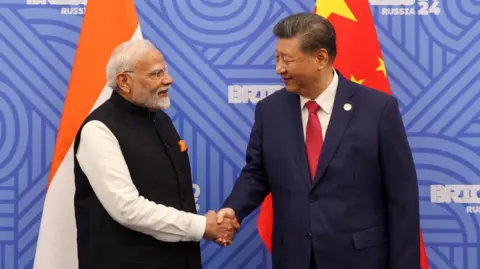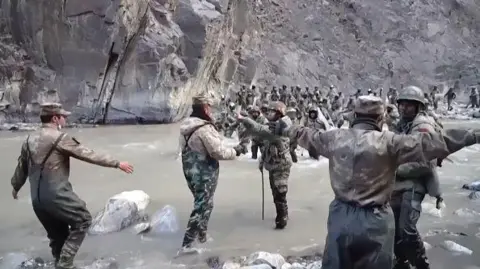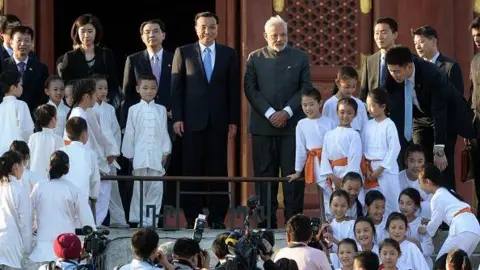What led to Modi and Xi meeting and thaw in ties

India and China have pledged to de-escalate tensions, four years after the deadly clashes on their disputed Himalayan border.
Indian Prime Minister Narendra Modi and Chinese President Xi Jinping met on Wednesday on the sidelines of the Brics (Brazil, Russia, India, China and South Africa) summit in Russia.
This was their first meeting since the hand-to-hand clashes of 2020 - their first fatal confrontation since 1975 - in which soldiers from both countries were killed.
India earlier this week announced they had reached an agreement on "disengagement and resolution of issues in these areas". On Wednesday, Modi and Xi welcomed the step and pledged to resume dialogue.
How did they get here?
The leaders have agreed to set an “early date” for a meeting between their top officials to resolve the issues.
India-China relations have been affected by tensions for decades - the root cause being an ill-defined, 3,440km (2,100-mile)-long disputed border. Rivers, lakes and snowcaps along the frontier mean the line often shifts, bringing soldiers face-to-face at many points, at times sparking a confrontation.
The two countries fought a war in 1962 in which India suffered a heavy defeat. Since then, there have been several skirmishes between the two sides.
When India repealed Article 370 of its constitution in 2019, taking away guaranteed autonomy for Indian-administered Kashmir, China denounced the move at the UN Security Council. Kashmir included the high-altitude Ladakh, parts of which China claims.
The clash in Galwan Valley in 2020 was their worst confrontation in decades. At least 20 Indian soldiers and four Chinese troops were killed.
Later that year, the two countries pulled back troops from some parts of the disputed border and pledged to de-escalate tensions - but the situation remained tense.
Troops from the two sides clashed again in the northern Sikkim area in 2021 and then in the Tawang sector of the border in 2022.
The military standoff also affected business ties between the two as Delhi increased its scrutiny of Chinese investments in the country and banned several popular Chinese mobile apps, including TikTok. It also stopped direct passenger flights to China.

While Wednesday's meeting between Modi and Xi saw their first formal talks since October 2019, the leaders had a pull-aside meeting at the G20 summit in Bali in 2022. Months later, China said they had reached a “consensus” during the meeting to restore bilateral ties.
The two leaders also met informally on the sidelines of the 2023 Brics summit in Johannesburg, where they agreed to intensify efforts to disengage and de-escalate, Reuters reports.
The same year, Indian Foreign Minister S Jaishankar met his Chinese counterpart Wang Yi on the sidelines of the Shanghai Cooperation Organisation (SCO) summit in Kazakhstan and agreed to step up talks.
Last month, Jaishankar said about 75% of the "disengagement" at the border had been sorted out.
A few days later, civil aviation authorities from the two sides also met and discussed early resumption of direct passenger flights.
Several media organisations, including Bloomberg, have reported that the Indian businesses have put pressure on the government to relax restrictions on China saying they hurt India’s high-end manufacturing, such as the chipmaking sector.
But Indian Finance Minister Nirmala Sitharaman said on Tuesday that India would be cautious while easing restrictions on Chinese businesses.

What was announced earlier this week?
On Monday, Jaishankar said the two countries had agreed to resume border patrols and go back to the situation that existed before the 2020 clash.
"With that we can say the disengagement with China has been completed," he added.
The Indian Army chief said the countries were now trying to restore trust. "That will happen once we are able to see each other and we are able to convince and reassure each other that we are not creeping into buffer zones that have been created," General Upendra Dwivedi said.
China's foreign ministry did not comment on specifics regarding the deal, but confirmed the two sides had “reached resolutions on relevant issues”.
"China commends the progress made and will continue working with India for the sound implementation of these resolutions," spokesperson Lin Jian said at a press conference on Tuesday.

What's next?
Modi and Xi have announced that their special representatives will meet to find solutions "to explore a fair, reasonable and mutually-acceptable solution to the boundary question", India’s external affairs ministry said in a statement.
It added that their ministers and other officials would also work to stabilise and rebuild bilateral relations.
The leaders talked about the importance of maintaining good ties, with PM Modi saying their relationship was vital for global peace.
“Maintaining peace and stability on the border should remain our priority. Mutual trust, mutual respect and mutual sensitivity should remain the basis of our relations,” he said.
The Brics summit was attended by leaders of 36 countries who discussed ways to reduce Global South’s dependence on dollars as currency. The summit was also attended by the UN Secretary-General, Antonio Guterres.
President Xi told Modi that the international community was watching the meeting closely. He said Delhi and Beijing must set an example for boosting the unity of developing countries and “to contribute to promoting multi-polarisation and democracy in international relations".
“China and India are both ancient civilisations, major developing countries and important members of the Global South. We are both at a crucial phase in our respective modernisation endeavours," he added.



.jpeg)





.jpeg)